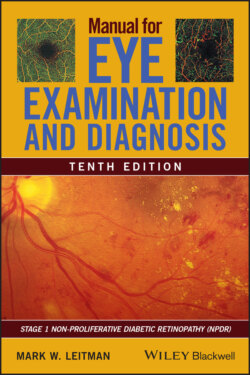Читать книгу Manual for Eye Examination and Diagnosis - Mark W. Leitman - Страница 15
Medications (ocular side effects)
ОглавлениеRecord patient medications. Those taking the following commonly prescribed drugs are often referred to an eye doctor to monitor ocular side effects.
Hydroxychloroquine (Plaquenil), initially used to treat malaria, is now a cornerstone medication used to treat autoimmune diseases, such as rheumatoid arthritis, lupus erythematosus, and Sjögren’s syndrome. It may cause retinal maculopathy with pigment changes resembling a “bull’s eye” (Fig. 4). Patients should get a baseline eye exam before starting medication. It includes visual acuity, Amsler grid, color vision, and examination of the retina to rule out preexisiting maculopathy. The patient should follow up every 6 months. Depending on the dosage and the chronicity of use, the eye doctor will determine if additional tests are necessary. Risk increases if dosage exceeds 5 mg/kg. Toxicity is also related to the cumulative amount of the drug with 1% occurrence in the first 5 years and 2% after 10 years and if there is coexisting macular degeneration. These high‐dose chronically treated patients may also have routine monitoring of their visual fields and optical coherence tomography (OCT) testing (Figs 463 and 464).
Fig 4 Bull’s eye maculopathy due to hydroxychloroquine in a patient with systemic lupus. The vasculitis and white cotton‐wool spots are due to lupus.
Source: Courtesy of Russel Rand, MD, and Arch. Ophthalmol., Apr. 2000, Vol. 118, pp. 588–589. Copyright 2000, American Medical Association. All rights reserved.
The retina is also adversely affected by phenothiazine tranquilizers (Fig. 5); niacin, a lipid‐lowering agent and interferon, used to treat multiple sclerosis and hepatitis C (Figs 6–8).
Ethambutol, rifampin, isoniazid, and streptomycin—taken mainly for tuberculosis—may all cause optic neuropathy. The antidepressants Paxil, Prozac, and Zoloft may also cause optic neuropathy. Corticosteroids may cause posterior subcapsular cataracts (Fig. 429), glaucoma, and a reduction in immunity that may increase the incidence of herpes virus and other infections.
Fig 5 Phenothiazine maculopathy with pigment mottling of the macula.
Flomax (tamsulosin), the most common treatment for an enlarged prostate gland, increases the complications in cataract surgery by decreasing the ability to dilate the pupil, a condition referred to as intraoperative floppy iris syndrome (IFIS). Pupillary expansion devices (Fig. 9) and additional pupillary dilating medications usually prevent complications.
Fig 6 Tamoxifen maculopathy with crystalline deposits (A); and (B) OCT showing crystals in the fovea.
Source: Courtesy of Joao Liporaci, MD.
Fig 7 Tamoxifen causes cataracts.
Fig 8 Besides causing maculopathy and cataracts, tamoxifen also causes crystal deposition in the cornea (keratopathy).
Source: Courtesy of Olga Zinchuk, MD, and Arch. Ophthalmol., July 2006, Vol. 124, p. 1046. Copyright 2006, American Medical Association. All rights reserved.
Stevens–Johnson syndrome (Fig. 10) is an immunologic reaction to a foreign substance, usually drugs, and most commonly sulfonamides, barbiturates, and penicillin. Some 100 other medications have also been implicated. It often affects the skin and mucous membranes. It could be fatal in 35% of cases.
Fig 9 Iris retractors are one method used to open poorly dilated pupils during cataract surgery. Note edge of lens implant (↑) behind iris.
Source: Courtesy of Bonnie Henderson, MD, Harvard Medical School.
Prostaglandin analogues are the most commonly prescribed glaucoma medications. Side effects include rare, irreversible darkening of the iris (Fig. 11) and reversible reduction in orbital fat (Fig. 12) with frequent darkening and lengthening of the lashes (Fig. 13). The lash changes are often considered desirable by patients and, consequently, lead to another prostaglandin medication called Latisse, which is specifically prescribed for cosmetic reasons to alter the lashes.
Fig 10 Stevens–Johnson syndrome with inflammation and adhesions of lid and bulbar conjunctiva.
Source: Reprinted with permission from Am. J. Ophthalmol., Aug. 2008, Vol. 1146, p. 271. Surgical strategies for fornix reconstruction. Based on Symblepharon Severity, Ahmad Kheirhah, Gabriella Blanco, Victoria Casas, Yasutaka Hayashida, Vadrecu K. Radu, Scheffer C.G. Tseng. Copyright 2008, Elsevier.
Amiodarone (Cordarone, Pacerone), one of the most potent anti‐arrhythmia drugs, and sildenafil (Viagra), tadalafil (Cialis), and vardenafil (Levitra), used to treat erectile dysfunction, have all been suspected of causing nonarteritic anterior ischemic optic neuropathy. Amiodarone almost always causes deposits in the cornea that rarely reduce vision, but may cause glare (Fig. 14).
Fig 11 Irreversible darkening of a blue iris after 3 months of latanoprost (Xalatan) therapy. This is the most common drug for treating glaucoma.
Source: Courtesy of N. Pfeiffer, MD, P. Appleton, MD, and Arch. Ophthalmol., Feb. 2011, Vol. 119, p. 191. Copyright 2001, American Medical Association. All rights reserved.
Fig 12 (A) Prostaglandin‐analogue induced fat atrophy of the left orbit with sunken superior sulcus after 1 year (↑) and darkened skin (∧). Courtesy of University of Iowa, Eyerounds.org. (B) After discontinuing eye drops that had been used in the left eye for 1 year, orbital fat atrophy, darkened and lengthened lashes, and improved skin pigmentation are seen.
Source: Courtesy of N. Pfeiffer, MD, P. Appleton, MD, and Arch. Ophthalmol., Feb. 2011, Vol. 119, p. 191. Copyright 2001, American Medical Association. All rights reserved.
Fig 13 After long‐term use of prostaglandin analogue in the left eye, the patient developed hyperpigmentation of periorbital skin, darkening and lengthening of lashes, and loss of orbital fat, causing a deepening of the upper eyelid sulcus.
Topiramate (Topamax), used to treat seizures and prevent migraine headaches, may cause angle‐closure glaucoma by causing edema of the ciliary body which pushes the iris toward the cornea closing the drainage system. Immediately discontinue the drug.
Fig 14 Epithelial deposits radiating from a central point in the inferior cornea. They occur in almost all patients with Fabry’s disease, which is an X‐linked systemic accumulation of a glycosphingolipid. Easily seen on a slit lamp exam, it can be the first clue in recognizing the presence of this disease, which is amenable to therapy. Indistinguishable deposits eventually appear in almost all patients using amiodarone and, less often, with hydroxychloroquine.
Source: Courtesy of Neal A. Sher, MD, and Arch. Ophthalmol., Aug. 1979, Vol. 97, pp. 671–676. Copyright 1979. American Medical Association. All rights reserved.
